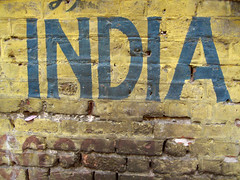World's largest university opens almost ALL its materials!
December 5, 2008, [MD]
Background
 India
is a country that I can never figure out. As striking as the poverty and
mismanagement was when I visited it this summer, I am continually struck
by the stream of innovation and wonderful initiatives coming from
institutions and individuals. I have written earlier about the open
access to primary school
textbooks
in Hindi and English, the Open Source Fellowships
workshop
at SARAI, the Universal
Library,
and finally the OpenCourseWare
initiative
from the Indian Institutes of Technology on
Youtube. I also gave a talk in
Delhi
on open education and open research for developing countries.
India
is a country that I can never figure out. As striking as the poverty and
mismanagement was when I visited it this summer, I am continually struck
by the stream of innovation and wonderful initiatives coming from
institutions and individuals. I have written earlier about the open
access to primary school
textbooks
in Hindi and English, the Open Source Fellowships
workshop
at SARAI, the Universal
Library,
and finally the OpenCourseWare
initiative
from the Indian Institutes of Technology on
Youtube. I also gave a talk in
Delhi
on open education and open research for developing countries.
Indira Gandhi National Open University (IGNOU) is the national distance learning university in India, and has 1.8 million students, served through over 1804 Study Centres coordinated by 58 Regional Centres. On their website they state that they are the largest university in the world. I have heard that China Central Radio and TV University might have as many as 2,6 million students, but I believe these are distributed over the 44 regional Radio and TV Universities. Either way, they are both massive systems!
An amazing amount of rich materials - videos
 Just
this summer, IGNOU has launched two different portals, whose richness of
material I believe to be unparalleled in the OER world! Similar to the
IITs, it has archived its videos on
Youtube.
With one channel for each “school” within the university (for example
School of education, School of
social sciences, etc), more than
thousand half an hour/hour long videos have been posted. (And some
channels only have an introductory video, so it can be surmised that
perhaps as much as double the amount will eventually be posted). These
videos are from TV programs that have earlier been produced for
dissemination through satellite channels and by VHS, and sometimes the
quality is a bit poor, but the breadth is spectacular.
Just
this summer, IGNOU has launched two different portals, whose richness of
material I believe to be unparalleled in the OER world! Similar to the
IITs, it has archived its videos on
Youtube.
With one channel for each “school” within the university (for example
School of education, School of
social sciences, etc), more than
thousand half an hour/hour long videos have been posted. (And some
channels only have an introductory video, so it can be surmised that
perhaps as much as double the amount will eventually be posted). These
videos are from TV programs that have earlier been produced for
dissemination through satellite channels and by VHS, and sometimes the
quality is a bit poor, but the breadth is spectacular.
I do find the IIT videos great, but this offering has me much more exciting, because it covers all fields. I have a feeling that there is a lot less culture in how to teach elementary physics, than in teaching about education, sociology and history, and for me this material is uniquely Indian and provides us a wonderful glimpse into another educational system and culture.
Most of the videos are in English, which is the common language of higher education in India, but there are also substantial collections in Hindi, especially in the humanities. For me, who is learning Hindi, this is a great motivation to learn more Hindi, and probably the only place I would easily come across lecture materials on a wide range of topics in the language. Here is one example on the universalization of primary education, which we have just been learning about in class this term:
There should really be something here for everyone. Here are many more examples:
- Preparing a research proposal
- The tribal situation in India
- Portrayal of Women in Indian TV Serials
- Newspaper layout and design
- Models of distance education
- [Writing for Children](
- Quality Control in Higher Education
- How students learn
- Planning a rural enterprise
- Writing news for radio
- Rural demography
- [Discourse and dominance: India in Western Writing](
There are also many great videos in Hindi, for example:
- [Hindi sahitya ka itihas]( (History of Hindi literature)
- Hindi kahani ka eek baatcheet (A chat about Hindi stories)
- [Mahilaye or bharat mein samagik parivartan]( (Women and social change in India)
Document repository
 Not
only has IGNOU released a huge slew of very interesting filmed lectures,
but they have digitalized and made open access almost all of their
teaching materials! We are not talking about curriculum lists and some
course PDFs, this is the entire teaching material that a student would
encounter, all modules written by IGNOU staff.
Not
only has IGNOU released a huge slew of very interesting filmed lectures,
but they have digitalized and made open access almost all of their
teaching materials! We are not talking about curriculum lists and some
course PDFs, this is the entire teaching material that a student would
encounter, all modules written by IGNOU staff.
They are employing a T-Space repository, and offer over 16,000 documents, most from 10-50 pages long. Here is a list of the different schools, and the number of documents available:
- School of Agriculture [660]
- School of Computer and Information Sciences [741]
- School of Continuing Education [1574]
- School of Education [1133]
- School of Engineering and Technology [3098]
- School of Health Sciences [622]
- School of Humanities [5942]
- School of Journalism and New Media Studies [17]
- School of Law [58]
- School of Management Studies [3727]
- School of Sciences [3579]
- School of Social Sciences [5099]
- School of Social Work [582]
- School of Tourism and Hospitality Service Sectoral Management [408]
The richness of this documentation is astounding, and because of it’s position both in India, and as a distance university, there are many unique collections:
- 87 documents on Distance Education, including an economic analysis of the China Radio and TV University (50 pages), research on distance education in India (30 pages), and cost effectiveness of distance education in Asia (22 pages).
- 21 documents on Rural Development in the Indian Context
- 58 documents on Cyber Law
- 60 documents on Disaster Management
- 79 documents on HIV Family Education
- 23 documents on Indian Economic Policy
- 38 documents on History of the Indian Economy
- 32 documents on Sociology in India
- 141 documents on Women’s empowerment and development
…I could go on. Most of these documents are scanned PDFs that have been OCRed (you can do full-text search on them, and you can copy and paste text).
As you can see, I am extremely excited about this initiative. I don’t think I am exaggerating when I state that this is the single largest (by far) source of current open educational resources that exists (ie. not counting the out of copyright books scanned by Google and OCA). Instead of providing just a curriculum list with links to books and articles that you cannot access if you are not member of a rich university, it provides everything. And in addition, you get a wealth of material that is unique to India/Asia, etc.
We often ask ourselves “do we need every institution to produce OCW”? Well, if we are talking about a hundred “101 Intro to Economics” at North-American institutions, then the answer is certainly no. But I would love to read the intro to Sociology from Nigeria, the Pedagogical survey from Hong Kong University, and the economics of small businesses from South Africa!
How could this be even better?
Yes, it is amazing, but it is amazing 1.0. A simple act could exponentially raise the amazingness (I apologize for the lack of academic language). Currently, all this material is in scanned PDFs (luckily OCRed) sitting in a T-Space repository. A number of downloads (but far from all) require a free registration, for some reason, and a very few are not available even with that registration (almost all I clicked were available though). However, all the material is copyrighted. “Items in eGyanKosh are protected by copyright, with all rights reserved by IGNOU, unless otherwise indicated.”
If instead all the material was licensed under a Creative Commons license, here’s what we could do: Begin finding great documents, extracting the text (Ctrl+A plus copy and paste gives you the OCRed text, then you just need to edit it to make it look OK and fix typos) and importing it into a Wiki - for example Connexions. That way, the documents would be so much more reusable. We could begin tagging them, breaking them into parts, hyperlinking between them, linking out to other content on the web, and creating an extremely rich resource for future open courses, as well as self-learners.
And in the process, we might be improving the original texts, something that IGNOU themselves could benefit from. Right now, I am not sure if it’s under Copyright because IGNOU hasn’t considered the options, or whether they made a conscious decision to Copyright it. I would love to find out, and I hope that Creative Commons India could play a role here.
What can we do? Use it!
IGNOU has given a wonderful gift to humanity. The best way we can support them, is to talk about it, and to use it. I am sure that some Peer2Peer University courses will benefit extremely, but I would also love to see some of my classes assign readings from this material. I think it would be a wonderful reversal of the near one-way flow of scholarship and teaching materials (”from the West to the Rest”) if classes at University of Toronto used IGNOU material. Not just because it’s free, but because it’s very good - and relevant. I am sure that this would strengthen IGNOU’s belief in going open (and perhaps convince them to become open “libre” and not just “gratis”), and perhaps show some Western institutions that if they don’t want to lose the battle for mindshare completely, they also have to open up.
Stian Pictures by Meanest Indian @ flickr, bijoy mohan @ flickr, the incredible how @ flickr
Stian Håklev December 5, 2008 Toronto, Canada comments powered by Disqus